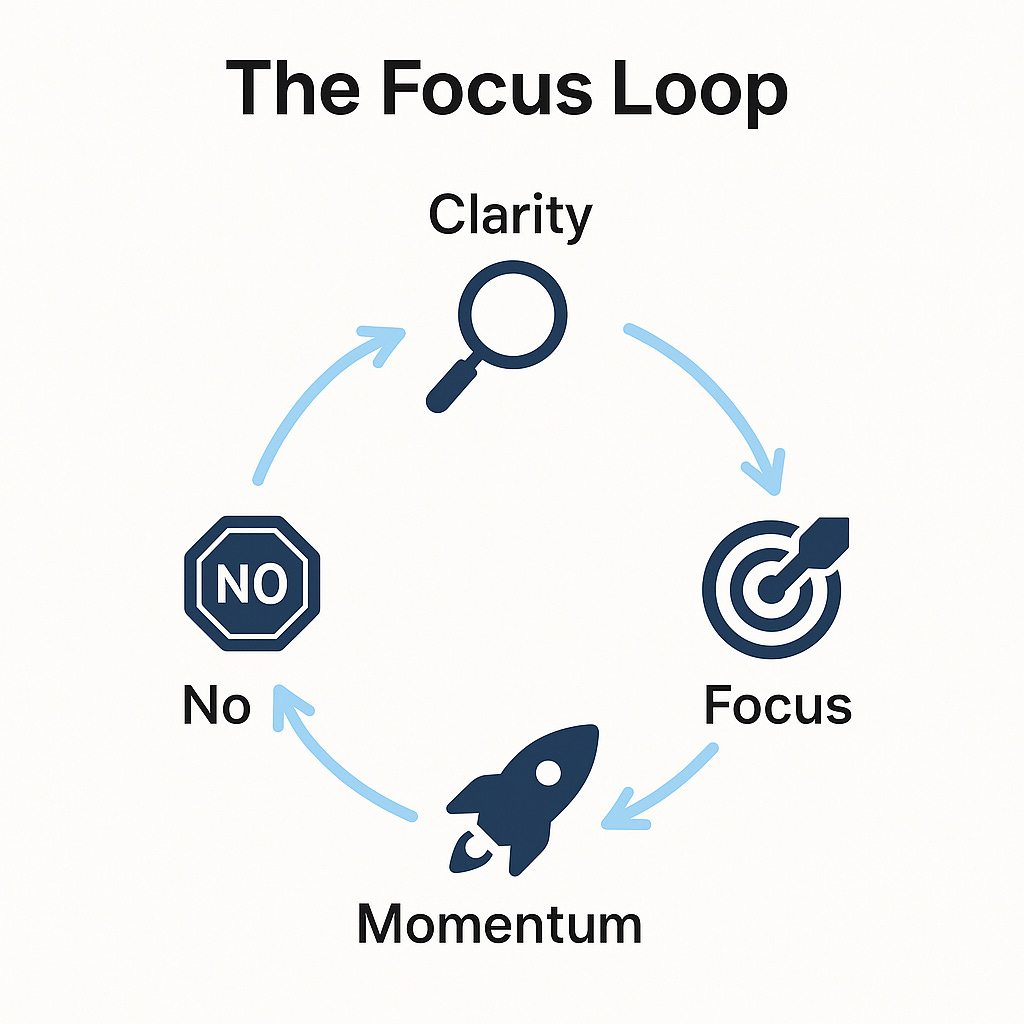The Focus Loop: How Great PMs Say No to Move Faster
How high-performing PMs protect focus, compound clarity, and build trust - by saying no.
🎧 Now a Podcast Conversation
This essay generated a candid conversation on The Product Leader’s Playbook, where two AI hosts unpack how saying “no” can actually speed up teams and sharpen product strategy.
→ [Listen on Spotify] | [Listen on Apple Podcasts]
The Invisible Cost of “Yes”
Early in my PM career, I thought my job was to deliver. More features. Faster timelines. Happier stakeholders.
I said yes a lot.
And for a while, it worked.
Until it didn’t.
One yes derailed a major launch. Another burned out my team. A third turned into a six-month slog that led nowhere.
That’s when I realized:
The most powerful thing a product manager can do isn’t say yes. It’s saying the right no.
Because every yes carries a hidden cost:
The opportunity you didn’t pursue.
The trust you strained with delays.
The energy you drained from your team.
Saying “no” well is not about shutting things down. It’s about steering toward what matters.
🔄 Introducing: The Focus Loop
Just like speed and learning reinforce each other in high-performing orgs, clarity and focus do too.
I call this the Focus Loop: a repeatable system for protecting attention, aligning priorities, and compounding velocity over time.
The Focus Loop has four stages:
Clarity – What problem are we really solving?
No – If it doesn’t align, say it early and clearly.
Focus – Double down on the right bets.
Momentum – Let alignment unlock speed.
Each cycle sharpens your roadmap and builds organizational trust. Not by doing more. But by doing what matters.
⚡️ The Turning Point
I once worked on a high-profile initiative when leadership requested a flashy new feature. It wasn’t on the roadmap. It wasn’t validated. But it had executive heat.
The old me might’ve said yes.
Instead, I asked three questions:
What problem are we solving?
What’s the measurable impact?
What would we delay or sacrifice by saying yes?
Within 30 minutes, we realigned. We pivoted to a more validated initiative with clearer user value.
The result?
We shipped faster — because we stayed focused.
✅ The Focus Filter: My 5-Factor Framework for Evaluation
When new requests come in, I run them through this filter. I even use this live in meetings with stakeholders.
Prioritization Factors
When evaluating whether to pursue a feature or initiative, consider the following five factors. Rate each on a scale of 1 to 5 (1 = low, 5 = high):
Strategic Fit
– Does this align with company or product objectives?Customer Impact
– Will it noticeably improve the user experience or deliver meaningful outcomes for users?Development Cost
– Is the engineering/design effort justified by the expected return?Timeline Impact
– Will this delay higher-priority work already in flight or on the roadmap?Opportunity Cost
– What are we giving up by choosing to focus on this instead?
How to use: If the total score is under 15, pause. Validate, reframe, or politely say no.
🔊 How to Say “No” Without Slowing Momentum
Saying “no” doesn’t have to feel like resistance. Done right, it feels like leadership.
Here are the reframes I use most:
“Let’s validate it first.” — Quick tests beat slow assumptions.
“Let’s compare priorities.” — Stack it against the current roadmap.
“Let’s phase it.” — Split big bets into testable slices.
“Let’s align on goals.” — Reconnect to outcomes.
The goal isn’t to shut down ideas. It’s to focus energy where it counts.
📆 My System for Protecting Focus
You don’t need to be the lone gatekeeper. You need a system.
1. Upstream: Reduce the Noise
Create intake forms with basic scoring.
Add guardrails: "We don’t build unless it maps to X objective."
Use async videos/docs for non-urgent requests.
2. Midstream: Make Tradeoffs Visible
Score requests collaboratively in meetings.
Always ask, "What are we saying no to by saying yes?"
3. Downstream: Build a Memory
Document every “not now” decision with rationale.
Revisit quarterly to catch patterns or shifting priorities.
This builds organizational muscle for disciplined prioritization.
🔧 Advanced Moves
Want to take it further? Here’s what I’ve seen work inside high-performing orgs:
Create a "No Committee": A small group reviews low-confidence ideas weekly. Not to kill them, but to redirect them.
Track declined requests: When something resurfaces 3+ times, it may be time to revisit.
Use pre-mortems: If we build this and it fails, why?
These systems keep you sharp and adaptable, without being reactive.
📅 Saying “No” Across Contexts
Saying "no" looks different depending on where you sit:
To a founder: Anchor in shared vision. Speak in narratives, not constraints.
To a matrixed stakeholder: Bring data, customer insights, and clear opportunity cost.
To your own team: Show empathy. Make space for ideas without overcommitting.
The most effective PMs are fluent in all three.
🔬 Final Thought: The Loop That Protects Focus
Just as velocity comes from feedback loops, clarity comes from decision loops.
Saying “no” isn’t about friction. It’s about flow. It’s how you preserve energy, sharpen direction, and create the space for truly meaningful work.
Let your “no” be the start of something better.
📰 Want to Go Deeper?
This essay generated a podcast episode on The Product Leader’s Playbook, where they break down:
The real risk of saying yes too often
How to turn prioritization into process
Why clarity is the real speed unlock
💬 Let’s Discuss
What’s the hardest “no” you’ve had to give as a PM?
How do you protect your team’s attention without slowing down?
Reply and let me know, or forward this to a product leader who needs to hear it.



